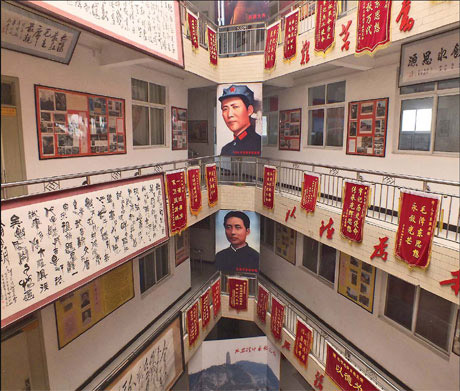Tribute to a great man
 |
|
The Mao Zedong Exhibition Hall is a five-story building with thousands of items on display. Ma Lie / China Daily |
 |
|
Zhang Deben (left) shows off his treasured badges bearing the image of Chairman Mao Zedong in the exhibition hall. The collection cost more than 10 million yuan. Ma Lie / China Daily |
Shaanxi businessman spends millions on a memorial hall for Chairman Mao
For Zhang Deben, the greatest thing in the world would be able to donate his museum in Xi'an to his country.
That was back in 2005, when Zhang's idea was that the museum - or Mao Zedong Exhibition Hall with its display of memorabilia of the late Chairman Mao Zedong and other leaders that Zhang had collected, would be a great place for a"red education" and could teach visitors a lot about the history of China's leaders. But Zhang wasn't expecting very good results.
In fact, Zhang does have the museum, now, located in the southern suburbs of the city of Xi'an, capital of Shaanxi province in Northwest China. And, when China Daily spoke with the 60-year-old farmer-turned-entrepreneur, sitting in his 40-square-meter office on the third floor of the museum, he explained that he intends to make every effort to improve the collection and then donate it to the county, free of charge.
He went on to explain that he received a document from the local cultural bureau, dated March 13, saying that his museum had been designated one of the city's key cultural projects to be improved.
"So, I think my efforts of many years are being appreciated," he said.
Zhang says that the museum opened to the public, for free, on Dec 23, 2007 and has had more than 140,000 visitors - from retired people, primary and middle school students, and college students to soldiers and governmental officials.
One committed visitor was Zhang Rui, 55, a retired worker from Xi'an's western suburbs, who took a two-hour bus ride to reach the museum, and told China Daily that she was impressed by the collection and really admired Zhang's effort in putting it together.
"My husband is a middle school teacher and told me about it after he brought a group students here. So, I asked some friends to come with me instead of going for a day of sightseeing and we all feel it was worth the effort."
Back when Zhang got the idea for the exhibition hall, he wasn't so certain, and, at first, "I just wanted a place to put all the items I'd collected."
Zhang was born in 1952, in the village of Yuedengge, in Xi'an, and faced a really hard life from an early age when his father died when he was only eight years old and left the family with no money for schooling.
But, Zhang recalls: "The school waived the tuition and I got some support from the local government to help me finish my primary and middle schooling. From that time on, I remembered the kindness of the Party and of Chairman Mao."
At 13, Zhang was given a Chairman Mao badge and felt so happy that he decided to try and get more of the precious emblems.
In 1979, when China began its opening-up and reforms, the 27-year-old Zhang left his village and decided to start his own business, while learning the carpentry trade and operated a steel and wood furniture factory in Xi'an, from which he earned his first real money.
Later, he turned his hand to construction work, for example, industrial parks and to renting out storehouses.
"That rental business allowed me to earn more than 2 million yuan ($317,000) a year, which allowed me to get my museum, without charging people, and without money from the local government," Zhang said.
Whenever he took business trips around the country for his furniture factory, Zhang would keep an eye open for whatever Mao badges he could fine and, as he got richer from the business, he would buy other Mao memorabilia, such as mugs with the Chairman's face on them or his quotations.
Then, as the collection grew, he began thinking about building an exhibition hall to let others enjoy his collection and remember the late Chairman.
Zhang also spent more than 3 million yuan on a five-story building with some 5,000 sq m of floor space for an exhibition hall where he could put some 230,000 items on display.
"The total collection on display here cost me more than 10 million yuan, but I think a person needs to do something socially meaningful if he gets rich," Zhang commented.
The exhibit is a testimony to the achievements of Mao Zedong and the early generation of revolutionaries in spreading red culture and carrying the revolutionary spirit forward.
The oldest item is a ceramic water tank from 1941 that commemorates the Battle of Zhongtiao Mountain, in Shanxi province, where a fierce fight raged between the Chinese army and the Japanese invaders, that same year.
"The tank has the date 1941 and the words 'Anti-Japanese War' on it. I found it in a village in Shanxi province and the owner wouldn't take any money when he learned that I wanted it for my public museum," Zhang said.
The museum is now considered by leaders as an ideal place to get some Party history and patriotic education and a local government department that deals with those affairs designated it a Party education and patriotic education center for college purposes.
On April 5, 2009, Li Ne, the daughter of the late Chairman, and her husband, Wang Jingqing paid a special visit to visit Zhang's museum and encouraged him to continue his red culture efforts.
"The love of Chairman Mao led me to embark on a life of collecting these items and I'll keep at it," Zhang concluded happily.














